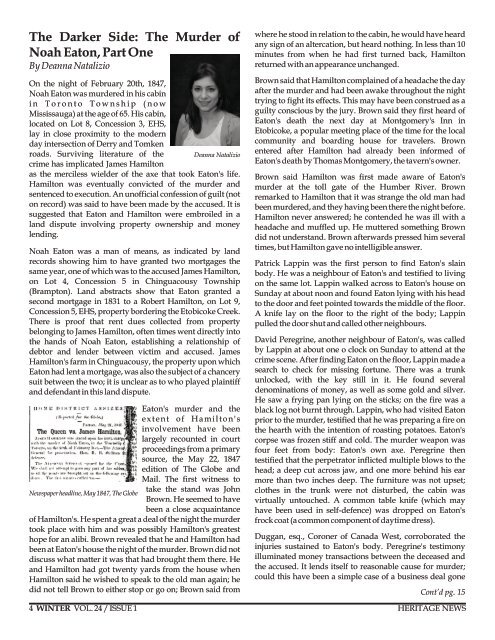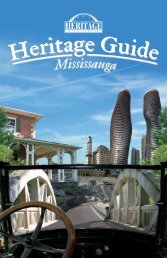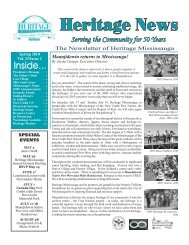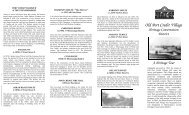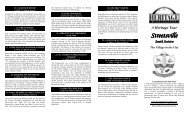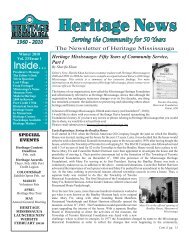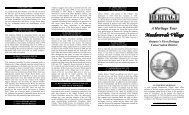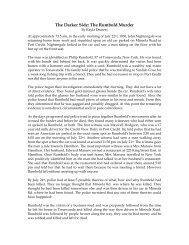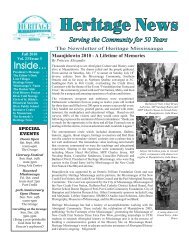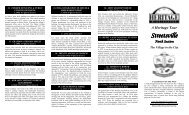Heritage News Winter 2011 - Heritage Mississauga
Heritage News Winter 2011 - Heritage Mississauga
Heritage News Winter 2011 - Heritage Mississauga
Create successful ePaper yourself
Turn your PDF publications into a flip-book with our unique Google optimized e-Paper software.
The Darker Side: The Murder of<br />
Noah Eaton, Part One<br />
By Deanna Natalizio<br />
On the night of February 20th, 1847,<br />
Noah Eaton was murdered in his cabin<br />
i n T o r o n t o T o w n s h i p ( n o w<br />
<strong>Mississauga</strong>) at the age of 65. His cabin,<br />
located on Lot 8, Concession 3, EHS,<br />
lay in close proximity to the modern<br />
day intersection of Derry and Tomken<br />
roads. Surviving literature of the Deanna Natalizio<br />
crime has implicated James Hamilton<br />
as the merciless wielder of the axe that took Eaton's life.<br />
Hamilton was eventually convicted of the murder and<br />
sentenced to execution. An unofficial confession of guilt (not<br />
on record) was said to have been made by the accused. It is<br />
suggested that Eaton and Hamilton were embroiled in a<br />
land dispute involving property ownership and money<br />
lending.<br />
Noah Eaton was a man of means, as indicated by land<br />
records showing him to have granted two mortgages the<br />
same year, one of which was to the accused James Hamilton,<br />
on Lot 4, Concession 5 in Chinguacousy Township<br />
(Brampton). Land abstracts show that Eaton granted a<br />
second mortgage in 1831 to a Robert Hamilton, on Lot 9,<br />
Concession 5, EHS, property bordering the Etobicoke Creek.<br />
There is proof that rent dues collected from property<br />
belonging to James Hamilton, often times went directly into<br />
the hands of Noah Eaton, establishing a relationship of<br />
debtor and lender between victim and accused. James<br />
Hamilton's farm in Chinguacousy, the property upon which<br />
Eaton had lent a mortgage, was also the subject of a chancery<br />
suit between the two; it is unclear as to who played plaintiff<br />
and defendant in this land dispute.<br />
Eaton's murder and the<br />
e x t e n t o f H a m i l t o n ' s<br />
involvement have been<br />
largely recounted in court<br />
proceedings from a primary<br />
source, the May 22, 1847<br />
edition of The Globe and<br />
Mail. The first witness to<br />
take the stand was John<br />
<strong>News</strong>paper headline, May 1847, The Globe<br />
Brown. He seemed to have<br />
been a close acquaintance<br />
of Hamilton's. He spent a great a deal of the night the murder<br />
took place with him and was possibly Hamilton's greatest<br />
hope for an alibi. Brown revealed that he and Hamilton had<br />
been at Eaton's house the night of the murder. Brown did not<br />
discuss what matter it was that had brought them there. He<br />
and Hamilton had got twenty yards from the house when<br />
Hamilton said he wished to speak to the old man again; he<br />
did not tell Brown to either stop or go on; Brown said from<br />
where he stood in relation to the cabin, he would have heard<br />
any sign of an altercation, but heard nothing. In less than 10<br />
minutes from when he had first turned back, Hamilton<br />
returned with an appearance unchanged.<br />
Brown said that Hamilton complained of a headache the day<br />
after the murder and had been awake throughout the night<br />
trying to fight its effects. This may have been construed as a<br />
guilty conscious by the jury. Brown said they first heard of<br />
Eaton's death the next day at Montgomery's Inn in<br />
Etobicoke, a popular meeting place of the time for the local<br />
community and boarding house for travelers. Brown<br />
entered after Hamilton had already been informed of<br />
Eaton's death by Thomas Montgomery, the tavern's owner.<br />
Brown said Hamilton was first made aware of Eaton's<br />
murder at the toll gate of the Humber River. Brown<br />
remarked to Hamilton that it was strange the old man had<br />
been murdered, and they having been there the night before.<br />
Hamilton never answered; he contended he was ill with a<br />
headache and muffled up. He muttered something Brown<br />
did not understand. Brown afterwards pressed him several<br />
times, but Hamilton gave no intelligible answer.<br />
Patrick Lappin was the first person to find Eaton's slain<br />
body. He was a neighbour of Eaton's and testified to living<br />
on the same lot. Lappin walked across to Eaton's house on<br />
Sunday at about noon and found Eaton lying with his head<br />
to the door and feet pointed towards the middle of the floor.<br />
A knife lay on the floor to the right of the body; Lappin<br />
pulled the door shut and called other neighbours.<br />
David Peregrine, another neighbour of Eaton's, was called<br />
by Lappin at about one o clock on Sunday to attend at the<br />
crime scene. After finding Eaton on the floor, Lappin made a<br />
search to check for missing fortune. There was a trunk<br />
unlocked, with the key still in it. He found several<br />
denominations of money, as well as some gold and silver.<br />
He saw a frying pan lying on the sticks; on the fire was a<br />
black log not burnt through. Lappin, who had visited Eaton<br />
prior to the murder, testified that he was preparing a fire on<br />
the hearth with the intention of roasting potatoes. Eaton's<br />
corpse was frozen stiff and cold. The murder weapon was<br />
four feet from body: Eaton's own axe. Peregrine then<br />
testified that the perpetrator inflicted multiple blows to the<br />
head; a deep cut across jaw, and one more behind his ear<br />
more than two inches deep. The furniture was not upset;<br />
clothes in the trunk were not disturbed, the cabin was<br />
virtually untouched. A common table knife (which may<br />
have been used in self-defence) was dropped on Eaton's<br />
frock coat (a common component of daytime dress).<br />
Duggan, esq., Coroner of Canada West, corroborated the<br />
injuries sustained to Eaton's body. Peregrine's testimony<br />
illuminated money transactions between the deceased and<br />
the accused. It lends itself to reasonable cause for murder;<br />
could this have been a simple case of a business deal gone<br />
Cont’d pg. 15<br />
4 WINTER VOL. 24 / ISSUE 1<br />
HERITAGE NEWS


